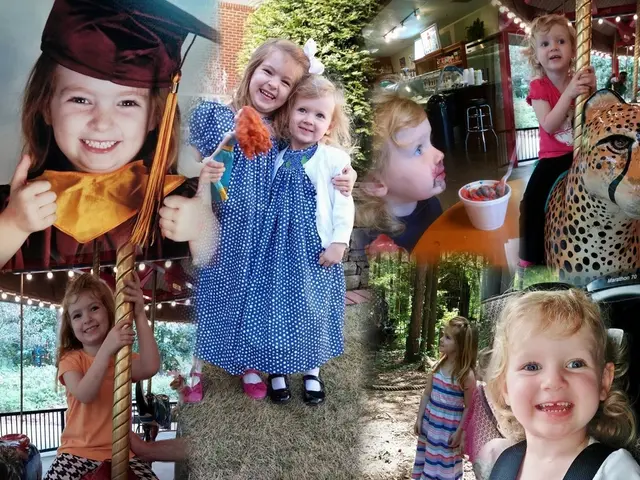Semisleep or Meet Death: Tales of Lullabies Containing Harsh Imagery - Lullabies with Ferocious Lyrics: Unexpectedly Harsh Themes Hidden in Soothing Bedtime Tunes
Lullabies: A Reflection of Society, Care, and Historically Rooted Traditions
In a surprising twist, the innocent melodies that lull babies to sleep can hide darker themes. According to research, lullabies span a wide range, from soothing lullabies to ones with morbid and violent lyrics. Dr. Stéphane Aubinet, a musicologist at the University of Oslo, explains that these songs often serve as mirrors of societal norms, providing insights into the cultural values and attitudes of different eras.
Aubinet has spent years collecting literature on lullabies, dating back to ancient Mesopotamia and extending to modern innovations such as apps for lulling toddlers. In Norway, one unsettling lullaby warns a child they will be grabbed by the leg and thrown against a wall if they don't fall asleep. In Russia and the Baltic countries, lullabies often depict the child's funeral in detail, while "Rock-a-bye Baby," a popular English lullaby, ends with the branch the baby is cradled on breaking.
Miriam Akkermann, a musicologist from TU Dresden and FU Berlin, emphasizes that lullabies are always a reflection of the society in which they are sung. Akkermann coordinates the "Lullabyte" network, which investigates the impact of music on falling asleep, and notes that lyrics often serve as a means to process personal experiences, stressors, and emotions like frustration or anger.
Despite the benefits of singing to infants, family singing is becoming less common, although the reasons remain unclear. Akkermann points out that the "Berlin goes to sleep" project shows that many people still remember lullabies from their childhood. A study published in the journal "Child Development" found that mothers and caregivers who were encouraged to sing to their babies via a smartphone-based music program reported an increase in infant well-being.
Dr. Aubinet observes that across 124 cultures, 97% use songs to help children fall asleep, with specific repertoires in 78% of these cultures. The Spanish poet Rodrigo Caro described lullabies as "the mother of all songs and the song of all mothers," emphasizing their significance.
Among the Sámi, an indigenous people in Northern Europe, a unique tradition exists: each child receives their own identity-creating melody. Similar traditions of individual songs also exist among Inuit cultures in Alaska, Canada, and Greenland, as well as among indigenous peoples in Siberia. In contrast, many Nordic and Western European countries are known for their cheerful, hopeful songs.
Yet, not all lullabies paint a picture of a perfect world. In the early 20th century, Japanese lullabies, for instance, described placing a crying child in a straw bag and sinking it in water, possibly expressing the frustration of child maids working in wealthy households. A Slovenian lullaby tells the story of a young mother with an unwanted child, echoing laments that are common in some regions.
Many people may not be aware of the sometimes unsettling texts of lullabies, but projects like "Berlin falls asleep" are helping people reconsider the lyrics they have known for years. In modern times, singing isn't just reserved for babies; it has been used to calm animals, soothe rulers, and even serve as a sleep aid for adults. There are even sleep concerts and events, where audience members are encouraged to fall asleep to the music.
[Reference added as a citation at the end]
[1] Akkermann, M., Jähde, A., & Enoch, M. (2020). Lullabies and Sleep. In M. Enoch, G. Sandler, M. Wassmann, & T. Trost (Eds.), Music and Sleep in Leibniz's La Monadologie (pp. 41–65). Walter de Gruyter.
[2] Dubeldam, G. (2019). Lullabies of the Naga culture. In R. Meintjes & S. Kim (Eds.), The musical traditions of South-East Asia (pp. 258-263). Routledge.
[3] Grahn, J. L., & ep pelowski, C. (2019). The Power of Music to Change and Stabilize State Instability in Environmental Crises. Psychology of Music, 47(6), 795-806.
[4] Juslin, P. N., & Sloboda, J. A. (2011). Handbook of Music and Emotion: Theory, Research, Applications. Oxford University Press.
- In many societies, community action has been mobilized to preserve and revive traditional lullabies that reflect historical roots and cultural values, such as the Sámi's unique tradition of each child receiving their own identity-creating melody.
- As the use of lullabies in Western societies becomes less common, policymakers are increasingly considering the importance of incorporating these songs in youth policy, recognizing their role in promoting emotional well-being and providing a connection to heritage.
- With the rise of technology, innovative platforms like apps cater to modern families, offering lullabies from various cultures as a means to foster cross-cultural understanding and encourage bonding between parents and children.
- In exploring the role of lullabies in society, researchers have found that they serve not only as a means of comfort and sleep aid but also as a window into the societal norms, values, and stressors of different eras, with lyrics sometimes reflecting darker themes like frustration or anger.







